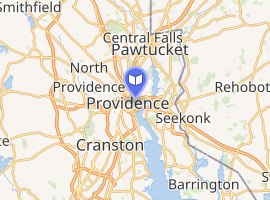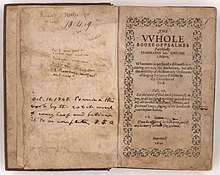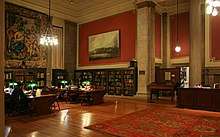John Carter Brown Library
The John Carter Brown Library is an independently funded research library of history and the humanities on the campus of Brown University in Providence, Rhode Island.[1] The library's rare book, manuscript, and map collections encompass a variety of topics related to the history of European exploration and colonization of the New World until circa 1825.
John Carter Brown Library | |
| Country | United States |
|---|---|
| Type | Research library |
| Scope | History and Humanities |
| Established | 1846 |
| Location | Brown University in Providence, Rhode Island |
| Coordinates | 41.8262°N 71.4032°W |
| Website | www |
| Map | |

| |
History

.png)

The Library originated in the mid-nineteenth century when it began as the private collection of John Carter Brown (1797–1874) who conceived of it being a collection of books written about the discovery of the New World, rather than a gentleman's financial investment or a rich man's adornment. Brown began collecting in 1846.[2][3] After John Carter Brown's death, his wife Sophia Augusta Brown continued collecting with the advisement of John Russell Bartlett (who served as an informal librarian) and Rush Hawkins.[4][5][6] This collecting passion was transmitted to his son, John Nicholas Brown (1861–1900). Until John Nicholas Brown's untimely death, the John Carter Brown Library was kept in a special fireproof room in the Brown family house in the 1792 Nightingale-Brown House. The will of John Nicholas Brown directed that within four years of his death, his trustees were to establish the collection, together with a building to house it, at a permanent site of their choice. They selected Brown University (named in honor of John Carter Brown's father, Nicholas Brown, Jr.).[7]
Scope and holdings
The collection of the John Carter Brown Library consists of more than 50,000 books written about both North and South America until roughly the end of the colonial era in the Americas, as well as around 16,000 specialized reference books providing supplementary information about the Library's holdings. The Library also holds a major collection of prints, manuscripts, and maps of the New World.
The collection of the John Carter Brown Library begins chronologically with fifteenth-century editions of Columbus's celebrated “letter” to the Spanish court announcing the discovery of lands to the west. The Library houses one of the largest collections of books printed in British North America before 1800, the world's most complete collection of Mexican works printed before 1600, the largest collection of printed works relating to Brazil before 1820, a collection of printed sources for the study of early Canada and the Caribbean, nearly three-quarters of all known imprints in the Native languages of North and South America from the colonial period, and the largest collection of political pamphlets produced at the time of the American revolution.
Collection highlights include the best preserved of eleven extant copies of Bay Psalm Book, the first book printed in British North America,[8] a Shakespeare First Folio, leaves from the Gutenberg Bible, a copy of the first Bible printed in British North America, one of four surviving copies of Benjamin Franklin's A Dissertation on Liberty and Necessity, Pleasure and Pain,[9] one of two copies of the hand-illustrated Tovar Codex, an important 16th-century source on Aztec culture,[10][11] and a copy of Vocabulario en lengua castellana y mexicana, the first dictionary published in the New World.
The Library also holds many important maps and prints relating to the New World. These maps include one of the first printed attempts to depict America in cartographic form (the so-called Stevens-Brown map, a prototype of the 1513 Ptolemy Orbis Typus); the first printed map of Hernán Cortés’s Mexico City, built on the ruins of the Aztec capital, Tenochtitlán; the earliest known printed plan of a European settlement in what is now the United States (a plan of Fort Caroline built by Huguenot settlers in 1565 near present-day Jacksonville, Florida); and one of the earliest maps to show the French exploration of the Mississippi River, attributed to Louis Joliet.
In 2012, a group of Brown undergraduates and scholars deciphered an encoded essay in the hand of Roger Williams, scrawled in the marginalia of a book within the Library's holdings. This essay, thought to be Williams's last, concerns a theological debate on the nature of baptism and Indian conversion.[12][13][14]
The building
The Library is housed in a Beaux-Arts style building, designed by the architects Shepley, Rutan, and Coolidge, and completed in 1904. The building was expanded in 1990, with funds from a donation by New Jersey financier, philanthropist, and Brown alumnus Finn M. W. Caspersen (B.A. 1963). The four-story annex, designed by the Washington, D.C., architects Hartman-Cox, was named the "Caspersen Building" in honor of Caspersen's parents.[15][16] It is located on the main green of Brown University.
The Archive of Early American Images
The Archive of Early American Images is drawn from the holdings of the John Carter Brown Library. The AEAI assists scholars in their quest for contemporary images to illustrate their research findings and to facilitate the study of historical images in their own right and in proper context. It is a unique resource for picture researchers, documentary filmmakers, and others looking for material for commercial use. Many of these American images come from books printed in the early modern period that have never been reproduced before.
As of August 2014, the database—which also includes a Map Collection, Political Cartoon Collection, and John Russell Bartlett Boundary Commission Collection—had about 11,270 images and is still growing. Images in this database are accompanied by extensive bibliographical and descriptive information and come from books in most European, and some Indigenous, languages from before c. 1825.
Librarians
Neil Safier has been the Director and Librarian of the John Carter Brown Library since 2013. Safier was preceded by: Edward L. Widmer (2006–2012); Norman Fiering (1983–2006); Thomas R. Adams (1958–1982); Lawrence C. Wroth (1924–1957);[17] Worthington C. Ford (1917–1922); Champlin Burrage (1916); George Parker Winship (1895–1915).
References
- Mitgang, Herbert (1988-02-15). "I.B.M. Exhibit Honors Columbus Anniversary". The New York Times. ISSN 0362-4331. Retrieved 2019-02-12.
- Reese, William S. (October 1989). "The First Hundred Years of Printing in British North America: Printers and Collectors". Proceedings of the American Antiquarian Society. 99: 337–39.
- Stockbridge, J. C. (August 23, 1877). "The John Carter Brown Library". New England Journal of Education. 6 (7): 74. JSTOR 44744778.
- Carlton, W. N. C. (1914). "The John Carter Brown Library: A History by George". The Papers of the Bibliographical Society of America. 8 (3/4): 135–39. doi:10.1086/pbsa.8.3_4.24292230. JSTOR 24292230.
- Stam, David H. (2001). International Dictionary of Library Histories. Taylor & Francis. ISBN 9781579582449.
- Casper, Scott E.; Groves, Jeffrey D.; Nissenbaum, Stephen W.; Winship, Michael (2009-09-15). A History of the Book in America: Volume 3: The Industrial Book, 1840-1880. Univ of North Carolina Press. ISBN 9780807868034.
- Stam, David H. (2016-01-08). International Dictionary of Library Histories. Routledge. ISBN 9781136777851.
- Shurtleff, Nath. B., and Bradford F. Swan. "Some Thoughts on the Bay Psalm Book of 1640: With a Census of Copies." The Yale University Library Gazette 22, no. 3 (1948): 51-76. http://www.jstor.org/stable/40857360.
- Franklin, Benjamin (2003). The Autobiography of Benjamin Franklin. Yale University Press. ISBN 9780300098587.
- Diel, Lori Boornazian (2018-12-12). The Codex Mexicanus: A Guide to Life in Late Sixteenth-Century New Spain. University of Texas Press. ISBN 9781477316757.
- Myers, Kathleen Ann (2015-10-15). In the Shadow of Cortés: Conversations Along the Route of Conquest. University of Arizona Press. ISBN 9780816532308.
- Powers, Martine (4 December 2012). "Brown students decode Roger Williams's shorthand". The Boston Globe. Retrieved 2019-05-04.
- Fisher, Linford D.; Lemons, J. Stanley; Mason-Brown, Lucas (2014). Decoding Roger Williams: The Lost Essay of Rhode Island's Founding Father. Baylor University Press. ISBN 9781481301046.
- Chaput, Erik J. "Book review: Beyond a doubt, it's Roger Williams' writing". providencejournal.com. Retrieved 2019-05-04.
- Brown University. The Dedication of the Caspersen Building September the Seventeenth A. D. MDCCCCXCI (Providence, Rhode Island: John Carter Brown Library, 1992).
- Mitchell, Martha. "John Carter Brown Library" in Encyclopedia Brunoniana (Providence, Rhode Island: Brown University Library, 1993)
- "Dr. Lawrence C. Wroth, Editor And Brown U. Librarian, Dies". The New York Times. 1970-12-26. ISSN 0362-4331. Retrieved 2019-05-04.
- Lawrence C. Wroth, The First Century of the John Carter Brown Library: A History with a Guide to the Collections, (1946).
- John Carter Brown Library, Annual Reports, 1901–1966, eight volumes, (1972).
- John Carter Brown Library,"The Dedication of the Caspersen Building," (1992).
External links
| Wikimedia Commons has media related to John Carter Brown Library. |
